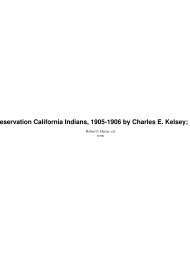A Trip to the - Yosemite Online
A Trip to the - Yosemite Online
A Trip to the - Yosemite Online
Create successful ePaper yourself
Turn your PDF publications into a flip-book with our unique Google optimized e-Paper software.
Immature black oak acorns in spring.<br />
black oak trees, aiding in <strong>the</strong> persistence of <strong>the</strong> oaks while<br />
ensuring <strong>the</strong> regrowth of grasses used for basket weaving.<br />
Today’s groves of black oaks are likely <strong>the</strong> results of<br />
centuries of management by Native Americans, as well<br />
as over a century of management by Euro-Americans.<br />
The pure black oak stands of <strong>the</strong> Valley may be artificial<br />
creations. Virtually everywhere else in <strong>the</strong> park, black<br />
oaks are mixed with <strong>the</strong> more abundant conifers such<br />
as ponderosa pine and incense cedar. This may explain<br />
why <strong>the</strong>se pure stands appear <strong>to</strong> be slowly declining; as<br />
adults die off, <strong>the</strong>y are not being replaced by younger<br />
trees. However, many o<strong>the</strong>r fac<strong>to</strong>rs could help <strong>to</strong> explain<br />
why we have pure stands of mature black oaks in <strong>the</strong><br />
Valley. These include changes in Valley hydrology, climate<br />
change, and changes in <strong>the</strong> nature and abundance of<br />
wildlife.<br />
The declining stands of black oak within <strong>Yosemite</strong><br />
Valley are located around <strong>the</strong> developed areas and adjacent<br />
<strong>to</strong> <strong>the</strong> larger meadows, particularly around <strong>Yosemite</strong><br />
Village, <strong>the</strong> Ahwahnee Hotel, and El Capitan Meadow.<br />
Although august in appearance, <strong>the</strong>se stands are composed<br />
of older individuals that are decaying and dying,<br />
with no seedlings or saplings around <strong>the</strong>m.<br />
In some ways, <strong>the</strong> ecology and status of pure black<br />
oak stands in <strong>Yosemite</strong> Valley mirrors <strong>the</strong> situation of<br />
oaks across California. A number of oak species don’t<br />
appear <strong>to</strong> be producing enough new trees <strong>to</strong> maintain<br />
existing populations; however, statewide, black oaks<br />
are not apparently one of <strong>the</strong> species that suffers from<br />
this problem.<br />
Since black oaks in <strong>Yosemite</strong> Valley are a significant<br />
biological and aes<strong>the</strong>tic resource for wildlife, visi<strong>to</strong>rs, and<br />
Native Americans, <strong>the</strong> <strong>Yosemite</strong> Fund granted support<br />
for a scientific study <strong>to</strong> assess <strong>the</strong>ir status and population<br />
trends within <strong>Yosemite</strong> Valley. The project examines<br />
<strong>the</strong> population structure of <strong>the</strong>se trees throughout<br />
<strong>the</strong> Valley, studies changes in <strong>the</strong>ir distribution in <strong>the</strong><br />
Valley over time using his<strong>to</strong>rical aerial pho<strong>to</strong>s, reviews<br />
BILL KUHN<br />
Native American use and manipulation of black oaks in<br />
<strong>Yosemite</strong>, and analyzes how past land use, fire, hydrological<br />
changes, and o<strong>the</strong>r fac<strong>to</strong>rs may be influencing <strong>the</strong><br />
future this species. When <strong>the</strong> project is completed this<br />
year, a final report and manuscripts will detail <strong>the</strong> study’s<br />
results. The final report will include recommendations<br />
<strong>to</strong> maintain black oak stands in <strong>Yosemite</strong> Valley, if this is<br />
deemed feasible.<br />
Preliminary results indicate that <strong>the</strong> structure of black<br />
oak populations varies greatly throughout <strong>the</strong> Valley.<br />
Whereas <strong>the</strong> pure, declining stands of black oak around<br />
<strong>the</strong> Valley are heavily skewed <strong>to</strong>ward older adults, o<strong>the</strong>r<br />
populations have individuals from many size classes.<br />
There are several possible explanations for why we see<br />
demographically skewed populations in some places but<br />
not o<strong>the</strong>rs. Mammalian browsing could be one fac<strong>to</strong>r.<br />
Oaks are a preferred food source for deer. If deer densities<br />
are high, excessive browsing could keep oak seedling<br />
and sapling densities low. Since deer are protected within<br />
<strong>the</strong> park, <strong>the</strong>ir densities are likely much greater now than<br />
when Native Americans inhabited <strong>the</strong> land. Conifers, on<br />
<strong>the</strong> o<strong>the</strong>r hand, are not a preferred food source of browsing<br />
animals, and we see many small, younger conifers,<br />
especially where <strong>the</strong> canopy is open and allows sufficient<br />
light <strong>to</strong> reach <strong>the</strong> forest floor. Changes in <strong>the</strong> hydrology of<br />
<strong>the</strong> Valley also may have affected <strong>the</strong> ability of black oaks<br />
<strong>to</strong> produce new seedlings from acorns in some areas. For<br />
example, <strong>the</strong> removal of a rock dam downstream of El<br />
Capitan Meadow may have made <strong>the</strong> land around some<br />
oak stands drier. Lack of fire, traditionally used by <strong>the</strong><br />
Miwok, may partially explain why we see such variation in<br />
black oak demographics throughout <strong>the</strong> Valley. Oaks are<br />
adapted <strong>to</strong> recover from fire, as is evident in areas in <strong>the</strong><br />
western part of <strong>the</strong> park that have burned in <strong>the</strong> last twenty<br />
years. Oaks may live for hundreds of years, surviving<br />
multiple fires by resprouting from <strong>the</strong> trunk base.<br />
Whatever <strong>the</strong> reasons for <strong>the</strong> variation in black oak<br />
stand demographics and health that we see throughout<br />
<strong>the</strong> Valley, <strong>the</strong> distribution and abundance of this species<br />
in <strong>the</strong> Valley is unlikely <strong>to</strong> change much in <strong>the</strong> short term.<br />
The presence of black oak may shift slightly in <strong>the</strong> Valley<br />
in decades <strong>to</strong> come, but this tree is unlikely <strong>to</strong> disappear.<br />
This singularly distinctive element of our park will<br />
remain here for present and future generations of visi<strong>to</strong>rs,<br />
Native Americans and wildlife <strong>to</strong> enjoy.<br />
Bill Kuhn is a Landscape Ecologist with <strong>the</strong> Division<br />
of Resources Management and Science in <strong>Yosemite</strong><br />
National Park.<br />
8 YOSEMITE ASSOCIATION, SUMMER 2007




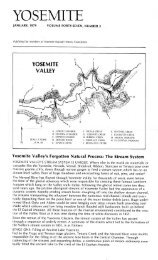
![(March 1982) [PDF] “We Are Pleased to Announce†- Yosemite Online](https://img.yumpu.com/51299748/1/190x242/march-1982-pdf-aeuroewe-are-pleased-to-announceaeur-yosemite-online.jpg?quality=85)
![[PDF] Old Horny, Yosemite's Unicorn Buck - Yosemite Online](https://img.yumpu.com/51269869/1/184x260/pdf-old-horny-yosemites-unicorn-buck-yosemite-online.jpg?quality=85)
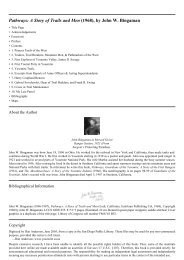
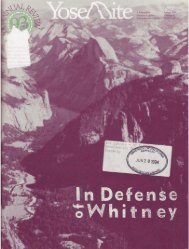
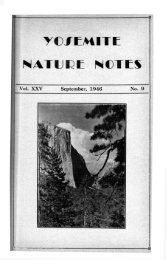
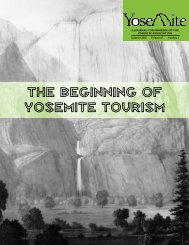
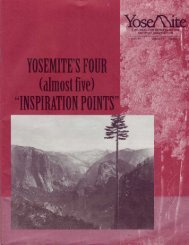
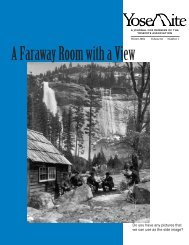
![1985 [PDF] - Yosemite](https://img.yumpu.com/48128837/1/184x260/1985-pdf-yosemite.jpg?quality=85)

